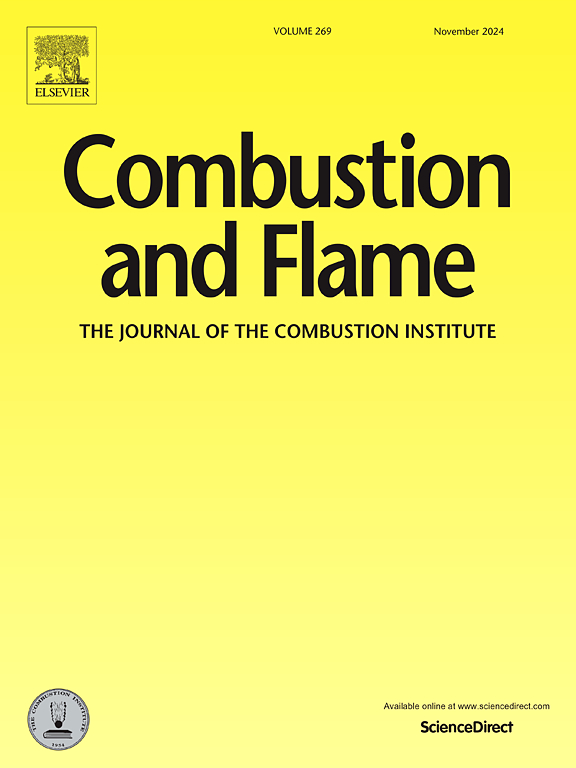Investigation of combustion characterization of single-point and two-point laser ignition of LPG-air mixture in a constant volume combustion chamber
IF 5.8
2区 工程技术
Q2 ENERGY & FUELS
引用次数: 0
Abstract
In this article, single and two-point laser-induced spark ignition (LISI) of liquified petroleum gas (LPG) - air mixture is investigated. The experiments were tested in a constant volume combustion chamber (CVCC) for an equivalence ratio (ϕ) of 0.6 to 1.2. The CVCC has four optical windows, which are used simultaneously for optical diagnostics and laser ignition. All experiments for both single and two-point laser ignition (LI) were tested at an initial chamber pressure of 6 bar and temperature of 298 K. Initially, the effect of distance between two plasms at focal points of 5 mm, 25 mm, and 45 mm apart on pressure time history was studied and observed a higher peak pressure and minimum combustion duration for 45 mm plasma spacing. It has been observed a peak pressure of 42.17 bar, 42.65 bar, and 43.92 bar for 5 mm, 25 mm, and 45 mm apart plasma spacing respectively for stoichiometric mixture, however, the combustion duration of 84.2 ms, 78.6 ms, and 73.2 ms were observed for 5 mm, 25 mm, and 45 mm apart plasma spacing respectively. The pressure-time (p-t) history for single and two-point LI was recorded, and a comparative study between the single and two-point LI of the LPG-air mixture analysis results in higher pressure with two-point LI of the LPG-air mixture compared to single-point LI for all equivalence ratios. The probability of laser ignition was investigated for single and two-point LI of LPG-air mixtures and observed a higher probability of ignition for two-point LI compared to single-point LI. With two-point LI the LPG-air mixture can be ignited up to an equivalence ratio of 0.52 however with single-point LI the mixture can be ignited up to an equivalence ratio of 0.56. Furthermore, the net heat release (NHR) was calculated for single and two-point LI and observed higher NHR for two-point LI compared to single-point LI. The NHR was observed to be 7872.75 J and 8111.88 J for single-point and two-point LI respectively at an equivalence ratio of 1.0. Lastly, the initial phases of the combustion progress for two-point LI were visualized using the Shadowgraphy technique with a high-speed camera. The growth of flame kernel for the LPG-air mixture of different ϕ (0.6, 0.8, 1.0, and 1.2) was visualized and analyzed and it has been observed the development of two flame kernels one on the upper side and another on the lower side of the chamber. Further, both flame kernel images show two toroidal rings with one front lobe propagating toward the incoming laser source. The flame kernel growth images obtained were used to measure the flame kernel propagation in different directions and it has been observed faster flame kernel propagation at an equivalence ratio of 1.0 in all directions.
本文研究了液化石油气(LPG)-空气混合物的单点和两点激光诱导火花点火(LISI)。实验在等效比 (ϕ) 为 0.6 至 1.2 的恒容燃烧室 (CVCC) 中进行。CVCC 有四个光学窗口,同时用于光学诊断和激光点火。所有的单点和两点激光点火(LI)实验都是在初始室压为 6 巴、温度为 298 K 的条件下进行的。最初,研究了相距 5 毫米、25 毫米和 45 毫米焦点的两个等离子体之间的距离对压力时间历程的影响,观察到 45 毫米等离子体间距的峰值压力更高,燃烧持续时间最短。研究观察到,等离子体间距分别为 5 毫米、25 毫米和 45 毫米时,对于化学计量混合物,峰值压力分别为 42.17 巴、42.65 巴和 43.92 巴,而等离子体间距分别为 5 毫米、25 毫米和 45 毫米时,燃烧持续时间分别为 84.2 毫秒、78.6 毫秒和 73.2 毫秒。记录了单点和两点 LI 的压力-时间(p-t)历史,并对液化石油气-空气混合物的单点和两点 LI 进行了比较研究,分析结果表明,在所有当量比下,液化石油气-空气混合物的两点 LI 比单点 LI 的压力更高。研究了液化石油气-空气混合物的单点液化点燃和两点液化点燃的激光点燃概率,发现两点液化点燃的激光点燃概率比单点液化点燃的激光点燃概率高。使用两点激光点火时,液化石油气-空气混合物的点火当量比可达 0.52,而使用单点激光点火时,混合物的点火当量比可达 0.56。此外,还计算了单点液化石油气和两点液化石油气的净释放热量(NHR),发现两点液化石油气的净释放热量高于单点液化石油气。在当量比为 1.0 时,单点燃烧和两点燃烧的净热释放量分别为 7872.75 J 和 8111.88 J。最后,利用高速相机的阴影成像技术对两点燃烧的初始阶段进行了观察。我们对不同ϕ(0.6、0.8、1.0 和 1.2)的液化石油气-空气混合物的焰芯生长情况进行了可视化分析,观察到在燃烧室的上侧和下侧分别形成了两个焰芯。此外,两个焰核图像都显示出两个环状环,其中一个前叶向着进入的激光源传播。获得的焰核生长图像被用于测量焰核在不同方向上的传播,观察到在等效比为 1.0 时,焰核在所有方向上的传播速度都较快。
本文章由计算机程序翻译,如有差异,请以英文原文为准。
求助全文
约1分钟内获得全文
求助全文
来源期刊

Combustion and Flame
工程技术-工程:化工
CiteScore
9.50
自引率
20.50%
发文量
631
审稿时长
3.8 months
期刊介绍:
The mission of the journal is to publish high quality work from experimental, theoretical, and computational investigations on the fundamentals of combustion phenomena and closely allied matters. While submissions in all pertinent areas are welcomed, past and recent focus of the journal has been on:
Development and validation of reaction kinetics, reduction of reaction mechanisms and modeling of combustion systems, including:
Conventional, alternative and surrogate fuels;
Pollutants;
Particulate and aerosol formation and abatement;
Heterogeneous processes.
Experimental, theoretical, and computational studies of laminar and turbulent combustion phenomena, including:
Premixed and non-premixed flames;
Ignition and extinction phenomena;
Flame propagation;
Flame structure;
Instabilities and swirl;
Flame spread;
Multi-phase reactants.
Advances in diagnostic and computational methods in combustion, including:
Measurement and simulation of scalar and vector properties;
Novel techniques;
State-of-the art applications.
Fundamental investigations of combustion technologies and systems, including:
Internal combustion engines;
Gas turbines;
Small- and large-scale stationary combustion and power generation;
Catalytic combustion;
Combustion synthesis;
Combustion under extreme conditions;
New concepts.
 求助内容:
求助内容: 应助结果提醒方式:
应助结果提醒方式:


